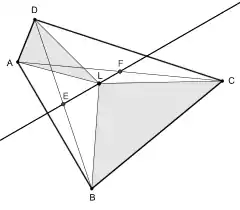Anne's theorem
Anne's theorem, named after the French mathematician Pierre-Leon Anne (1806–1850), is a statement from Euclidean geometry, which describes an equality of certain areas within a convex quadrilateral.

The sums of the areas of opposing triangles are equal, that is
Area(BCL) + Area(DAL) = Area(LAB) + Area(DLC)
Area(BCL) + Area(DAL) = Area(LAB) + Area(DLC)
Specifically, it states:
- Let ABCD be a convex quadrilateral with diagonals AC and BD, that is not a parallelogram. Furthermore let E and F be the midpoints of the diagonals and L be an arbitrary point in the interior of ABCD. L forms four triangles with the edges of ABCD. If the two sums of areas of opposite triangles are equal ( Area(BCL) + Area(DAL) = Area(LAB) + Area(DLC) ), then the point L is located on the Newton line, that is the line which connects E and F.
For a parallelogram the Newton line does not exist since both midpoints of the diagonals coincide with point of intersection of the diagonals. Moreover the area identity of the theorem holds in this case for any inner point of the quadrilateral.
The converse of Anne's theorem is true as well, that is for any point on the Newton line which is an inner point of the quadrilateral, the area identity holds.
References
- Claudi Alsina, Roger B. Nelsen: Charming Proofs: A Journey Into Elegant Mathematics. MAA, 2010, ISBN 9780883853481, pp. 116–117 (online copy, p. 116, at Google Books)
- Ross Honsberger: More Mathematical Morsels. Cambridge University Press, 1991, ISBN 0883853140, pp. 174–175 online copy, p. 174, at Google Books)
External links
- Newton's and Léon Anne's Theorems at cut-the-knot.org
- Andrew Jobbings: The Converse of Leon Anne's Theorem
- Weisstein, Eric W. "Leon Anne's Theorem". MathWorld.
This article is issued from Wikipedia. The text is licensed under Creative Commons - Attribution - Sharealike. Additional terms may apply for the media files.